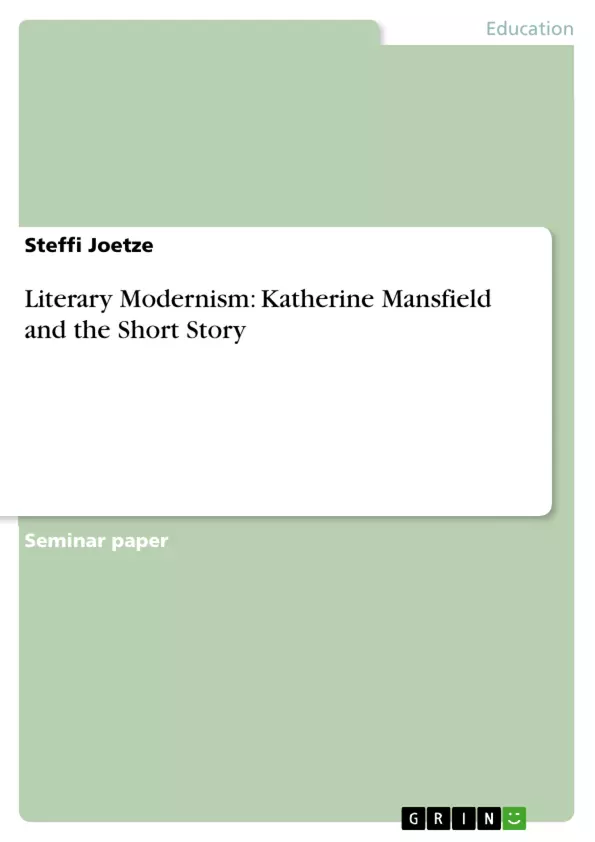Modernism is widely acknowledged as probably the most important and influential artistic-cultural phenomenon of the twentieth-century, whether it is considered primarily as a movement, a period, a genre, a style or an ideology (cf. Poplawski 2003, p. 5).
In order to find out what is so special about the literary period between 1901 and 1939 extra-literary developments and contexts as well as thematic and formal innovations according to modernism will be considered at first in this paper.
Afterwards the modernist short story, as an important ‘invention’ of modernist writers, and its main characteristics and features are of interest. In this respect some writers of the modernist era, such as Joseph Conrad, James Joyce, Sherwood Anderson etc., and some of their short stories will be considered to get a completed picture of the topic. Katherine Mansfield, one of the great Modernist innovators of twentieth-century English literature, plays a central role in this regard. After a biographical overview her contribution to the ‘invention’ of the short story with special interest to characteristic features of her way of writing will be presented.
Finally, the aim should be to explore how one of Katherine Mansfield’s last short stories ‘The Fly’ can be used for English language teaching. At first a short plot summary and various kinds of interpretations are given to get at the real meaning of the story. Then a concrete example of classroom treatment, including a worksheet, will be dealt with. This worksheet gives attention to text gaps, which can be found within the short story, in the way that they can be seen as ‘adjunctive structures’ and can be used for text work in groups.
Table of Contents
- Introduction
- (Literary) 'Modernism'
- Extra-Literary Conditions and Influences
- Themes and Formal Innovations
- The Modernist Short Story
- Beginnings, Development and Main Features
- Katherine Mansfield
- Life
- Contribution to the 'Invention' of the Short Story and Thematic Innovations
- Katherine Mansfield 'The Fly'
- Summary
- Interpretations
- A Short Story for English Language Teaching?
- Adjunctive Structures'
- Worksheet
- Conclusion
Objectives and Key Themes
This paper examines the significance of literary modernism in the 20th century, focusing on its extra-literary influences, thematic and formal innovations, and its impact on the development of the short story. The paper will explore the work of Katherine Mansfield, a pivotal figure in modernist literature, and specifically analyze her short story "The Fly" for its potential as a tool for English language teaching.
- Extra-literary influences of modernism, including scientific discoveries, social science, and philosophical thought.
- Key themes of modernism, such as uncertainty, perception, consciousness, and the impact of social and political forces.
- Formal innovations of modernist writing, including stream of consciousness, interior monologue, and symbolism.
- The development and characteristics of the modernist short story.
- Katherine Mansfield's contribution to the evolution of the short story and her unique writing style.
Chapter Summaries
- Introduction: Introduces the concept of literary modernism and its significance as a defining artistic and cultural movement of the 20th century. The chapter outlines the paper's objectives, focusing on exploring the impact of extra-literary influences, thematic and formal innovations, and the development of the modernist short story, specifically through the work of Katherine Mansfield.
- (Literary) 'Modernism': Discusses the extra-literary conditions and influences that shaped modernism. It explores how scientific discoveries, social science, and philosophical thought, particularly from figures like Darwin, Marx, Engels, Freud, and Nietzsche, contributed to a sense of uncertainty and a shift in understanding of human nature and the world.
- The Modernist Short Story: This chapter delves into the beginnings, development, and main features of the modernist short story. It examines key characteristics of this genre, such as the use of symbolism, stream of consciousness, and interior monologue, and highlights the contributions of significant modernist authors like Joseph Conrad, James Joyce, and Sherwood Anderson.
- Katherine Mansfield 'The Fly': This chapter focuses on Katherine Mansfield's short story "The Fly," providing a summary of the plot and exploring various interpretations of its meaning. The chapter then considers the story's potential for English language teaching, including a discussion of "adjunctive structures" within the text and a sample worksheet for classroom use.
Keywords
This paper centers around key concepts such as literary modernism, extra-literary influences, uncertainty, consciousness, perception, stream of consciousness, interior monologue, symbolism, the modernist short story, Katherine Mansfield, "The Fly," and English language teaching. It delves into the ways in which these concepts intersect, illuminating the unique characteristics of modernist literature and its application in educational settings.
- Quote paper
- Steffi Joetze (Author), 2010, Literary Modernism: Katherine Mansfield and the Short Story, Munich, GRIN Verlag, https://www.grin.com/document/174063



